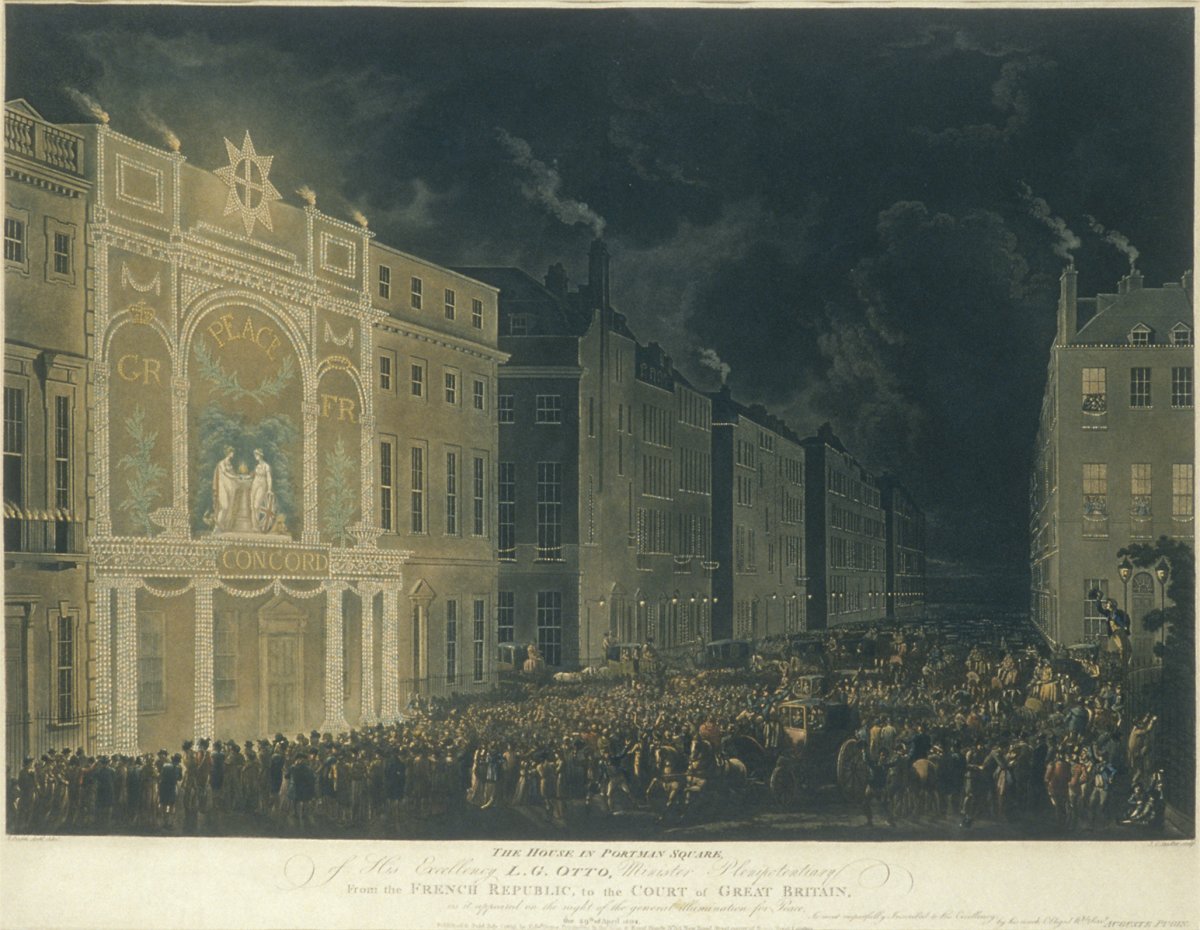The House in Portman Square of His Excellency L. G. Otto, Minister Plenipotentiary from the French Republic, to the Court of Great Britain as it appeared on the night of the general illumination for Peace, the 29th of April 1802
Auguste Charles Pugin (1762 - 1832)
Joseph Constantine Stadler (1755 - 1828)
Hand-coloured aquatint
published 1 July 1802
-
About the work
- Location
-
Country: France
City: Paris
Place: British Embassy
This work shows the London residence of Louis-Guillaume Otto, Comte de Mosloy (1753/54-1817) in Portman Square, Westminster, in 1802. Jacques Lauriston, first aide-de-camp to Napoleon, was selected to convey consent to the Peace of Amiens in 1802. Lauriston arrived at the home of Otto and was reportedly ‘greeted with enthusiastic cheers by a vast concourse of people’ before the signing of the preliminary agreement for the Treaty in Downing Street.
In his book ‘Old and New London’ (1872-78), Edward Walford explains the illuminations seen in this work:
‘A very curious print is in existence showing the illumination of M. Otto's house in celebration of this event. On the front was a row of large oil lamps forming the word 'Concord' and on either side were the initials 'G.R.' for George III, and 'R.F.' for Republique Francaise... This illumination was somewhat unfortunate, for a London mob, unwittingly, interpreted 'Concord' into 'Conquered'. All the ambassador's windows were smashed in consequence. When the word 'Concord' was removed, its place was supplied by 'Amitie'; but the stupid mob read this as 'Enmity', and insisted on its removal also.'
-
About the artist
Augustus Charles Pugin fled to England in the 1790s, either because of his Royalism or on account of a duel. He seems to have landed in Wales, where he became a friend of the architect John Nash (1752–1835). He worked as a general artist, providing designs for Nash and painting scenery, before moving to London and studying at the Royal Academy Schools. He first exhibited architectural designs at the Academy in 1799 and, from 1807, began to exhibit at the Old Watercolour Society. Pugin worked on several projects for Rudolf Ackermann, including plates for The Microcosm of London and The Abbey Church of Westminster (1811–12). During this period he set up a school of architectural drawing and began to publish his own works. He was the father of A. W. N. Pugin, who designed the interiors of the Houses of Parliament.
Joseph Constantine Stadler was a prolific German émigré engraver of images after his contemporaries. His engravings are wide-ranging in subject matter and include landscapes, seascapes and portraits, as well as military, sporting and decorative subjects. Stadler was employed by the leading print publisher of the time, John Boydell (1720-1804). On 23 March 1799 Stadler married Ann Elizabeth Sandman at St Anne’s Church, Soho, in London. He was living in Knightsbridge when he died at the age of 73.
-
Explore
- Places
- Subjects
- Materials & Techniques
-
Details
- Title
- The House in Portman Square of His Excellency L. G. Otto, Minister Plenipotentiary from the French Republic, to the Court of Great Britain as it appeared on the night of the general illumination for Peace, the 29th of April 1802
- Date
- published 1 July 1802
- Medium
- Hand-coloured aquatint
- Dimensions
- height: 65.50 cm, width: 84.00 cm
- Acquisition
- Purchased from Christie's, 24 May 2002
- Provenance
- Christie's, "The London Sale", 24 May 2002 (Lot 52)
- GAC number
- 17692